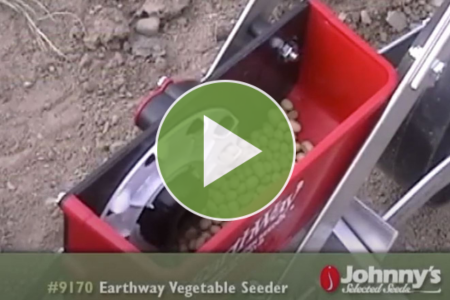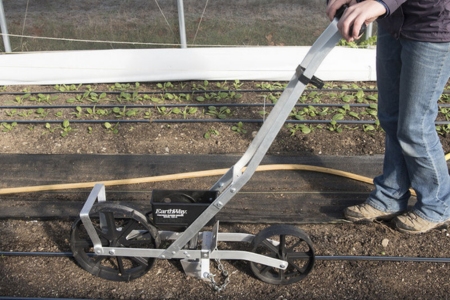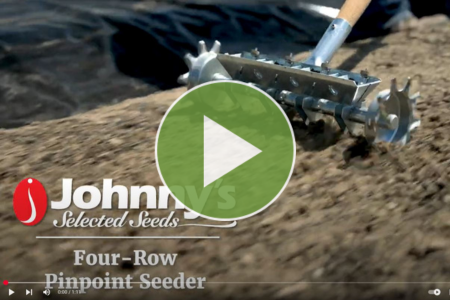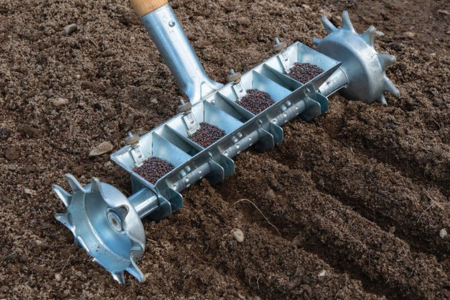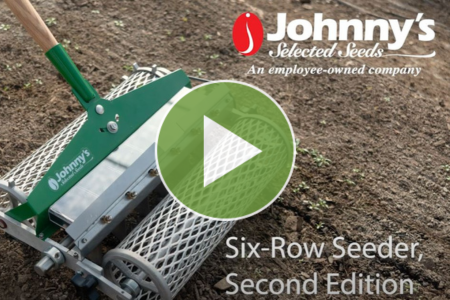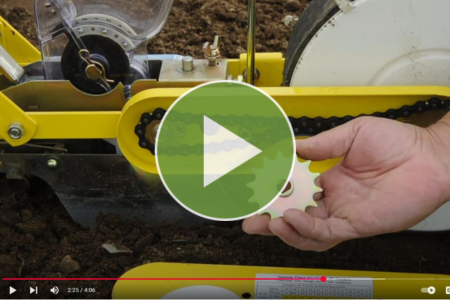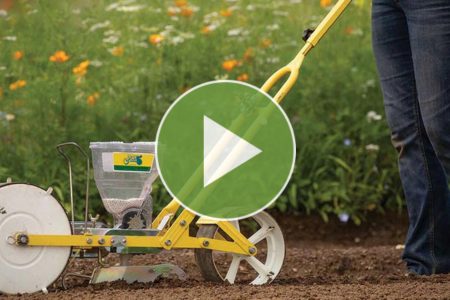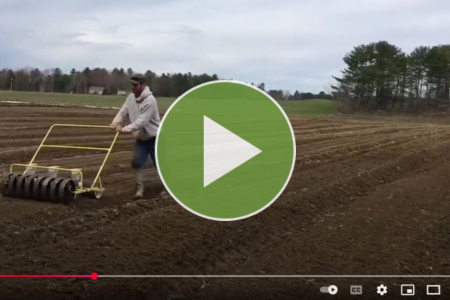- Top 10 Cut-Flower Varieties for Direct Seeding
- Guide to Choosing a Garden Seeder
- Johnny's Seeders | Printable 4-pp Brochure (PDF)
- Direct-Seeding Guidelines | Benefits, Methods & How to Avoid Problems
- Spinach Seed Roller Pack | Tech Sheet (PDF)
- Direct-Seeded Vegetable Crops | Seed Quantity & Average Yield Chart
- Direct-Seeded Vegetable Crops | Seed Quantity & Average Yield Chart (PDF)
- EarthWay Vegetable Seeder | Fertilizer Attachment | Assembly & Instructions | Tech Sheet (PDF)
- EarthWay Vegetable Seeder | Assembly & Operating Instructions | Tech Sheet (PDF)
- Video: Using the EarthWay Vegetable Seeder
- Ev-N-Spred Broadcast Seeder-Spreader | Instructions & Features | Tech Sheet (PDF)
- Ev-N-Spred Broadcast Seeder-Spreader | Lever Settings | Tech Sheet (PDF)
- Four-Row Pinpoint Seeder | Assembly & Instruction Manual (PDF)
- Four-Row Pinpoint Seeder | Replacement Parts List (PDF)
- One-Row Pinpoint Seeder | Assembly & Instruction Manual (PDF)
- Jang JP Roller Trial | FARM SEED Cross-Reference Chart (XLSX)
- Jang JP Roller Trial | CUT-FLOWER Variety Cross-Reference Chart (XLSX)
- Jang JP Roller Trial | HERB Variety Cross-Reference Chart (XLSX)
- Jang JP Roller Trial | SUNFLOWER VARIETIES Cross-Reference Chart (XLSX)
- Jang JP Roller Trial | VEGETABLE Variety Cross-Reference Chart (XLS)
- Jang JP Series Roller Selection Guide | Tech Sheet (PDF)
- Jang JP Series Seeders | Comparison Chart (PDF)
- Jang JP-1 Push Seeder | Operation Manual (PDF)
- Jang JP Series Seeders | Roller Sizes & Applications | Comparison Chart (PDF)
- Jang TD Series Seeders | Comparison Chart (PDF)
- Jang TD-1 Precision Push Seeder | Operation Manual (PDF)
- Video: Jang JP-1 Seeder | Anatomy & Use
- Video: Jang JP-6W Clean Seeder | A Quick Demo at Farmer Kev's in West Gardiner, Maine
- Video: Brad Waugh & JM Fortier on Improving the Six-Row Seeder
- Six-Row Seeder | Assembly & Instruction Manual (PDF)
- Replacement Hopper for the Six-Row Seeder | Instructions | Tech Sheet (PDF)
- Six-Row Seeder, 2nd Edition | Replacement Parts List & Schematic | PDF
- Video: Johnny's Six-Row Seeder • Second Edition
- Video: Using the Six-Row Seeder
- Video: Using the Four-Row Pinpoint Seeder in a Raised Garden Bed | Quick Demo
- Video: Direct-Seeding Your Garden | Tips & Recommendations with Niki Jabbour
- Video: Using the Easy-Plant Jab-Type Planter
- Using the Four-Row Pinpoint Seeder
- Connecta® Row Pro™ Hiller/Furrower | Connecta Tool System
- Video: Jang Seeder: How to Maximize Its Potential | Johnny's Webinar Series
- Little Green Seeding Machine | Seeding Rates & Seed Compatibility
- Little Green Seeding Machine | Comparison Chart
- Jang Seeder: How to Maximize Its Potential | Johnny's Educational Webinar Resources
- Jang JP Roller | Testing Grid (PDF)
- Webinar Slide Deck | Jang Seeder: How to Maximize Its Potential | 28-pp PDF
- Seeding Date Calculator | To Target Specific Harvest Dates | Johnny's Selected Seeds
Guide to Choosing a Garden Seeder
✓ Efficiency ✓ Precision ✓ Affordability
Precision Seeders for the Market Garden or Homestead
When it's time to choose a new seeder, growers and gardeners look for a design that suits their individual style and strikes the right balance between efficiency, precision, and affordability.
Benefits of Precision Seeders
Precision seeders offer several benefits to the grower including:
- Improved Germination: a seeder can help establish good seed-to-soil contact and ensure that seed is planted at the optimum depth. Together, these can help improve overall germination rates.
- Less seed waste: precision seeders accurately drop seed, reducing over- or under-seeding.
- Even and straight rows, leading to a uniform stand that makes thinning and cultivation more efficient.
- Labor savings: the right seeder can save enormous amounts of time.
- More predictable yields: precision seeders have repeatability; in other words, they allow you to seed crops at an accurate rate every time, which turns help you to achieve more predictable yields.
Comparing Seeders
| Precision Seeder Comparison Chart | |||||||
|---|---|---|---|---|---|---|---|
| Seeder | Recommended Use | In-Row Spacing | # Rows | Row Spacing | # of Hole Sizes Available | Assembled Weight | Cost |
| EarthWay® | A wide variety of small and large seeds. Best for use with larger seeds like corn, peas, and beans. | 1–12”, depending upon plate used. | 1 | n/a | 11 seed plate sizes available, plus a blank plate for creating custom sizing | 7 ½ lbs. | $ |
| One-Row Pinpoint | For small-seeded crops planted in greenhouses, raised beds, and tight spaces. | 1", 1 ¼", or 2 ¼", depending upon hole size used. | 1 | n/a | 6 | 2 ½ lbs. | $$ |
| Four-Row Pinpoint | Densely planted, small-seeded crops in greenhouses, raised beds, and tight spaces. | 1” or 1 ¼”, depending upon hole size used. | Up to 4 | Min. 2 ¼”, Max. 6 ¾” | 4, plus an additional 4 with Extended Range Shaft | 4 1⁄10 lbs. | $$ |
| Jang JP-1 | Can be used to sow most uniform seeds of a small and medium size, and some larger seed, with the appropriate roller. | ½”–28” depending upon roller size and sprocket combination | 1 | n/a | Wide range of roller sizes available, plus blank for creating custom sizing | 25 lbs. | $$$ |
| Six Row | Densely planted, small-seeded crops such as salad mix, baby greens, carrots, or radish. | 1”, 2 ½”, or 4” depending upon drive belt ratio. | Up to 6 | Min. 2 ¼”, Max. 11 ¼" | 4, plus an additional 4 with Extended Range Shaft | 13 1⁄10 lbs. | $$$$ |
| Jang TD-1 | Large seeds such as beans, corn, peas, including large, flat seeds like pumpkins | 2–42” depending upon plate size and sprocket combination. | 1 | n/a | 3 seed plate sizes available, plus blank plates for creating custom sizing | 22 ½ lbs. | $$$$ |
| Jang JP-Three-Row | Can be used to sow most uniform seeds of a small and medium size, and some larger seed, with the appropriate roller. | ½"–28” depending upon roller size and sprocket combination | Up to 5; includes 3 seed hoppers | 3–6” | Wide range of roller sizes available, plus blank for creating custom sizing | 35 lbs. | $$$$$ |
| Jang JP-Five-Row | Can be used to sow most uniform seeds of a small and medium size, and some larger seed, with the appropriate roller. | ½"–28” depending upon roller size and sprocket combination. | Up to 5; includes 5 seed hoppers | 3–12” | Wide range of roller sizes available, plus blank for creating custom sizing | 39 ⅘ lbs. | $$$$$ |
| Jang JP-Six-Row | Can be used to sow most uniform seeds of a small and medium size, and some larger seed, with the appropriate roller. | ½"–28” depending upon roller size and sprocket combination. | Up to 8; includes 6 seed hoppers | 3–12” | Wide range of roller sizes available, plus blank for creating custom sizing | 39 ⅘ lbs. | $$$$$ |
EarthWay Precision Garden Seeder
The EarthWay is a well-loved, cost-effective choice for the home gardener and market gardener alike. For seeding long rows of large-seeded crops like peas and beans, this is a great choice. It uses a seed plate to space the seed; 7 interchangeable plates afford a variety of seed sizes and spacing options. According to Paul Gallione, Certified Crop Advisor and now-retired Johnny's Territory Sales Rep, who still has the EarthWay Seeder he bought back in 1991, the Earthway is a “Jack of all trades, master of none.” He used it as his primary seeder for years, but adds, “In terms of the 'ride,' going from an EarthWay to a Jang JP-1 is like trading in a '68 Volkswagon—jiggle, wiggle, and shake!—for a brand-new Cadillac.”
Pros:
- Affordable.
- Design allows for seeding in a continuous operating motion by opening the furrow, planting and spacing the seed, covering and packing the soil.
- Adjustable 30" row marker can be set to the desired between-row spacing to mark your next row, enabling you to achieve parallel rows.
- One revolution of the EarthWay = 36", so with 1 full rotation of the wheel, you get 3' of direct-seeded row.
- Comes with a set of 6 seed plates suitable for planting over 20 common types of vegetables.
- Can be easily converted into a fertilizer/side dresser with the EarthWay Fertilizer Attachment.
Cons:
- Small seed may not be singulated (in other words, there may be wasted seed, and follow-up thinning required). However, the Earthway does singulate pelleted seed, beets, and peas.
- Works best with larger seeds and a well-filled hopper, not with smaller seeds or an underloaded hopper.
- Hopper is uncovered, exposing seed to the elements.
- Not as rugged as Jang seeders, although its lightweight design makes it usable by nearly everyone.
Pinpoint Seeders
Four-Row Pinpoint Seeder
The Four-Row Pinpoint seeder is designed for densely seeded crops such as salad/brassica mixes, but can accommodate some other crops, such as spinach and cilantro. It is the tool of choice for greenhouse plantings and other tight spaces. This seeder seeds a 30” bed in 3 passes.
Pros:
- Super light, but sturdy.
- Works great in tight spaces like small greenhouses.
- Uncomplicated and easy to maintain, with few moving parts.
- Easy to fill and empty.
- Adjustable for seeding rate, seeding, depth, and seeder angle.
- Economical for the job it does.
Cons:
- Must have fine tilth for optimum performance, so increased bed preparation needed; does not perform well with lots of field debris.
- Drops seed at 1" spacings — seed spacing is not adjustable (varying row spacings can be achieved, however, based on which seed hoppers you fill).
- Relatively easy to adjust and operate but less ergonomic than other designs. Seed depth is controlled by raising or lowering the angle between the handle and the soil, which can require some finesse.
- Must keep eye on the wheel tines to be sure they are spinning and dropping seed and that hoppers are not empty (provided you're paying attention, however, it is very easy to go back over a missed section).
- Small hoppers drop seed most efficiently when they're full, so they need relatively frequent refilling, and it's semi-difficult to retrieve unused seed.
One-Row Pinpoint Seeder
The One-Row Pinpoint Seeder has most of the same features and limitations offered by its four-row counterpart. We developed the single-row version in response to many requests from growers for an even lighter-weight, highly maneuverable accurate pinpoint seeder.
Six-Row Seeder, Second Edition
Designed for densely spaced crops (salad/brassica mixes), this seeder can seed a full 30” bed in only two passes, making it a great choice for labor-saving on the market garden.
Pros:
- More adjustable than Four-Row Seeder.
- Includes front roller, which helps it function in wider range of conditions than the Four-Row Seeder.
- Easier to retrieve seed from the hoppers than from those of the Four-Row Seeder.
- Highly reliable, given proper calibration and bed preparation.
- Only two passes required to seed a 30”bed.
Cons:
- Similar to the pinpoint seeders, must have fine tilth for optimum performance; increased bed preparation needed. Does not tolerate a lot of field debris.
- Larger/more to maneuver than the Four-Row Seeder.
Jang Seeders
Jang JP-1
The Jang is the industry standard in precision seeding and a mainstay on many market gardens. The seeder uses seed rollers to singulate and space seed. Each roller has holes of varying number and dimension to allow accurate singulation of very small-through medium-sized seeds, as well as pelleted seeds and some larger seeds. Swap the rollers out in the field with the quick-release hopper and adjust the seeding density in-row using interchangeable gears.
Pros:
- Very versatile, with a multitude of seed rollers and plow-shoe options (double-row double-disc openers), as well as customizable blanks.
- Scalable: Options include hoppers, rollers, and plow heads, all compatible with multi-row versions. You can start with just the JP-1 and eventually upgrade to JP-3, JP-5, or JP-6, and still be able to use the parts originally purchased. There is no need to buy an entire new system (for some people at least), as the scale of the operation grows.
- Not as particular about soil conditions as some seeders; able to more precisely handle rougher terrain than other seeders.
- Rugged construction.
Cons:
- May be on the heavy side for some people.
Jang JP Three, Five, and Six Row Seeders
These seeders are designed for small- to medium-size seeds (some functionality with larger sizes) and offer a large range of in-row spacing options plus the added efficiency of seeding multiple rows in a single pass. A versatile and reliable option for the commercial market gardener.
Jang TD-1
Great for precision-planting corn, peas, beans, and other large seeds, even large flat seeds. Unlike the Jang JP Series seeders which use seed rollers, the TD Series uses seed plates. Seeds are dropped at spacings that range from 2⅜" all the way out to 84", which are adjustable by using sprockets to determine exact drop.
Pros:
- Functions well even with a small amount of seed in the hopper.
- Large (7.3-quart/7-liter), transparent, lidded hopper makes it easy to monitor and protect your seed, and its quick release, funnel-shaped design facilitates retrieving unused seed and swapping out plates.
Cons:
- May be on the heavy side for some people.
- Less versatile than the Jang JP Series, but—after all—it has a different specialization.
Growers & Their Jangs—Some Recommendations & Feedback
Having recently expanded our line of Jang Seeders, we wanted to follow up with our customers and find out how well the equipment was working out for them. We checked in with a diversity of growers and gardeners around the country who had recently purchased a Jang Seeder from Johnny's, and asked for feedback about utility, value, and performance.
- Kevin Leavitt • Farmer Kev's Organics, West Gardiner, Maine
We met up with Kevin one morning in late April, when the fields were still somewhat cloddy and damp. Kevin had prepped row after row of 100-foot-long raised beds, despite an exceptionally cool, wet spring, and we were eager to see if the fields were dry enough to plant. Kevin loaded three alternating hoppers of his new Jang JP-6W, and as you can see in the video clip below, was able to sow three rows concurrently in just a few minutes. We hope the Jang JP-6W proves invaluable in his rapidly expanding farmshare delivery business here in Central Maine.
- Brittany & Kevin Overshiner • Upswing Farm, Hopkinton, Massachusetts
Upswing Farm is a small, diversified vegetable farm on the border of Ashland and Holliston, Massachusetts, run by Brittany and Kevin Overshiner. Brittany shared the following about her Jang Seeders with Ken Fine, her Territory Sales Rep (retired). “Bought the first one in 2012… Worth every penny… With the various rollers and by modifying the gear settings you can use a precise amount of seed… This conserves seed and, more importantly, results in NO THINNING.” Brittany and Kevin use use other methods at Upswing for large-seed crops such as peas and beans.
- Brandon Dodge • Rastafarm, Reisterstown, Maryland
Rastafarmi is a small organic farm in Reisterstown (Boring), Maryland run by Brandon and his partner Megan. When his Territory Sales Rep, Paul Gallione (retired), asked Brandon for feedback about his new Jang, Brandon reported that he was very happy. “It took a few weeks to get used to it,” he added, but then it was great. Brandon and Paul reviewed the Johnny's Roller Trial Results / Variety Cross-Reference Charts, a set of spreadsheets that list which Jang Roller works best for direct-sowing over 200 varieties/seed types of crops. Brandon said he thought Johnny's product-support information was excellent, and gave the following recommendation to prospective Jang customers: “Buy it… Learn it… It WILL work!”
- Liz Graznak • Happy Hollow Farm, Jamestown, Missouri
Happy Hollow Farm is an organic operation nestled in the foothills of the Missouri River, where Liz Graznak grows produce to supply CSA shares and sell at the Columbia farmer's market. Liz has a background in plant breeding and also does trials with Missouri State University on her farm. Her Territory Sales Rep at the time, Randy Cummings, talked with Liz talked about the Jang Seeder she recently purchased.
“ It takes more time to set up for the seed you want to use, but once it is set up it is easier to use than the EarthWay. It does a good job tamping the seed, much better than the EarthWay. It does a much better job seeding carrots… In the past, I've shied away from doing direct-seeding because the EarthWay isn't that fabulous, but I think I'll be doing more direct-seeding because of the Jang… I plan on picking up more rollers for it in the future. I definitely like it… I heard about the Jang at the MOSES conference years ago from another vendor, but when I was ready I found it was easier to buy it from Johnny's. The Jang Seeder for me is one of those purchases for which I felt I needed to reach a certain point financially, as I had been using the EarthWay up until this time. I bought the EarthWay, then the Six-Row Seeder for all my babyleaf in the high tunnel, and this year decided it was time to buy the Jang.… Four weeks ago was my first big seeding, but we struggled with 11 inches of rain, which washed everything out. Just this last week I was able to get back out to work the ground again, reshaping beds, and used the Jang again to seed. ”
- Jeff Scott • Vino, Alabama
Jeff is a methodical, mechanically-oriented individual who after retiring from the US Army, decided to apply his ingenuity to growing crops. First he built himself a high tunnel with help from a NRSC grant, then installed rain-water catchment as well as an elegant drip irrigation system. Next he designed a dirt sifter to prepare superfine topsoil so he could grow straight carrots. He also devised an attachment for his tractor tiller to spit out 40"-wide, 5"-tall, perfectly flat-surfaced beds in his tunnel. “Design is the biggest part of fun,” according to Jeff. “It's been as much of a science lab as a growing exercise.” He's also “exploring the finer options of composting.” It thus comes as no surprise that when he was ready to buy a seeder, he researched his options carefully. “I watched some YouTube videos, and talked to some of my neighbors. They have the EarthWay Seeder. I listened to what they had to say, then talked to Rod [Heyerdahl],” his regional Territory Sales Representative (now retired). “I elected to get a Jang, and the next question was whether to get the single-, two- or three-row version. I went with the three-row because it was more versatile—more options. I'm all about options, and the more options I've got, the better I like it.”
- Alex Nielsen • Ukiah, California
Finally we heard from the West Coast, where commercial grower Alex Nielsen had simply this to say about how his new Jang was working out for him: “Love it!”
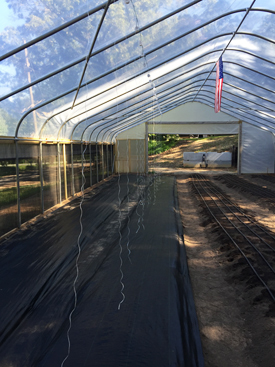
Other Types of Seeders
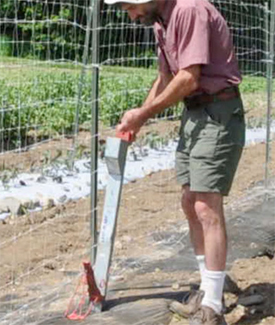
Every grower has a style, all their own, and seeders therefore come in a range of designs to suit different functions and grower needs. Here are some additional types of seeders to fit various other seeding purposes.
- Ev-n-Spred Seeder/Spreader
This seeder is designed by the reliable people at EarthWay to perform a function that is almost as old as the practice of agriculture—hand-sowing by scattering seed across a broad area. Lightweight and easy to carry, the Ev-n-Spred is useful for broadcasting cover crops or grass seed, and can also be used to spread fertilizer or other particulate amendments. Spread widths are determined by the particle size and density. - Easy-Plant Jab-Type Seeder
This seeder, too, is lightweight and easy to carry and use in an upright position, but in contrast to theEv-n-Spred, the Easy-Plant Jab-Type Seeder is specifically designed for pinpoint-planting of large-seeded crops such as sunflowers, corn, beans, pumpkins, and squash. It can drill through mulch and is very handy for filling in bare spots.
- Seeders For Indoor Seed-Starting
For seeds that are not direct-sown but started instead as transplants, there are a variety of seeder designs for sowing trays and other containers. For those in search of seeders for hand sowing indoors, here are some of the best.
Learn More
- EarthWay Vegetable Seeder • Assembly & Operation Instructions • Tech Sheet (PDF)
- Jang JP Series Seeders • Comparison Chart (PDF)
- Jang JP Series • Roller Selection Guide • Tech Sheet (PDF)
- Jang JP Series • Roller Sizes & Applications • Comparison Chart (PDF)
- Jang JP1 Seeder • Operation Manual • Tech Sheet (PDF)
- Jang TD Series Seeders • Comparison Chart (PDF)
- Jang TD1 Precision Seeder • Operation Manual • Tech Sheet (PDF)
- Six-Row Seeder, 2nd Edition • Assembly & Instruction Manual • Tech Sheet (PDF)



